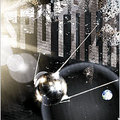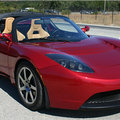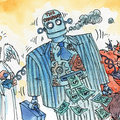THE Thai festival calendar begins this week with the New Year soaking of Songkran, a nationwide water fight with roots in traditional Buddhist cleansing ceremonies. In recent years, the celebration has become more like St. Patrick's Day with water guns as Thai and farang (foreign) tourists guzzle alcohol and hose one another down in pursuit of what locals proudly call sanuk, or fun.
But if you can't make it for Songkran, there are other options. The year ahead, 2550 on the Thai calendar, is a candy store of festivals, colorful parades and celebrations that have, for the most part, stayed close to their roots, offering you the opportunity to steep yourself not just in Singha beer, but in local culture and history as well. Expressing core aspects of Thai-ness like Buddhism, animism and agriculture, these festivals and national holidays will expand your mind and up your sum total of sanuk.
On May 10 the annual Royal Plowing Ceremony will be performed on the Sanam Luang parade ground near the Royal Palace in Bangkok. Not unlike our Groundhog Day, the observance centers on a pair of oxen that predict the weather and the country's financial future. In the presence of royalty (lately it's been the crown prince instead of his 79-year-old father, King Bhumibol Adulyadej), the ancient ritual begins at an auspicious time determined by Hindu priests robed in gold and white silk who present the oxen with a choice of seven trays of food and potables. As the animals graze on rice, corn, green beans, water, grass, sesame seeds or whiskey, the priests interpret their selections to predict rainfall, crop success, the economy and foreign trade. Grains foretell a good harvest, water signifies an abundance of meat, green beans portend plentiful fruit, and a slurp of whiskey is good news for the economy.
With the forecast made, onlookers scramble to collect scattered ceremonial rice seeds consecrated by royalty to usher in the planting season. Get there early to get a good viewing spot and “bring snacks, drinking water, hats and sunscreen,” said Lyle Sinrod Walter, a native Washingtonian who has lived in Bangkok for six years.
The second full moon of May (the 31st this year) is Visakha Bucha, the holiest of the Buddhist holidays, celebrating the date Buddha was born, attained enlightenment and entered nirvana. To honor that trifecta of religious achievement, festivities are held all over the country. Bangkok and the northern city of Chiang Mai offer two of the most profound and popular celebrations. The week before the holiday, the Grand Palace in Bangkok is host to a televised flower-strewn procession bearing a Buddha relic into Sanam Luang park where the masses (1.2 million visitors in 2005) pay their respects.
By the shine of the full moon, you'll want to be in Chiang Mai, the ancient capital of the Northern Kingdom and home to the temple of Doi Suthep, perched more than a mile above the city. On Visakha Bucha, shortly after sunset, a procession of monks carries lanterns and candles on a seven-and-a-half mile pilgrimage to the top and circumambulates the major stupa three times. The celebration is more spiritual than sanuk, but it's an opportunity to experience one of the country's holiest rites.
A daytime visit to Doi Suthep can be equally inspiring. The views of the city and surrounding countryside make for great pictures. Followers walk the perimeter spinning prayer wheels and sending their wishes into the universe, and you can receive a blessing from one of the many monks at practice. If you're up to it, climb the 300-step Naga staircase to the top, but newly rebuilt cable cars are a less strenuous option.
If Songkran is comparable to St. Patrick's Day and the oxen in Sanam Luang to Punxsutawney Phil, then the late June festival of Phi Ta Khon is Thai Halloween. Locals in the Loei Province near Laos hide under frightening masks made from coconut leaves and rice husks and make mischief in a loud and colorful procession through the small district of Dan Sai. Like Halloween, the Ghost Festival has religious-folkloric origins. Buddhist celebrants honor Vessendara, an incarnation of the Buddha whose return to his hometown, the tale goes, was celebrated by the village spirits and ghosts awakened by the party noise. The belief in village spirits comes from older traditions celebrated by the Isaan minority who make their home in this mountainous province. The festival kicks off the rainmaking celebrations that include the Isaan Rocket Festival in the town of Yasothon, where locals shoot off occasionally dangerous (sometimes even lethal) homemade rockets.
Every October (Oct. 11 to 19 this year) the resort island of Phuket sheds its bikini-blanketed reputation to hold one of the most bizarre and dramatic celebrations on the Thai calendar. On the sixth day of the Vegetarian Festival, tens of thousands of gawkers come to watch a procession of self-impaled celebrants. Spirit mediums meditate to reach a trancelike state so they can pierce their mouths and cheeks with all manner of objects: swords, picks, branches and even unusual household items (a standing fan in the case of one brave young man). Once adorned, they process through the winding streets, occasionally falling into a reverie or stopping at colorful homemade altars to accept offerings. Part of a 10-day strict abstinence from meat eating among Thais of Chinese descent, the self-piercing is said to bring spiritual cleansing and “make merit” with the nine gods invoked during the festival. As if they haven't already proved their mettle, the mediums finish by walking over beds of hot coals.
Thais are proud of their country's long, peaceful history, free of colonization or foreign occupation. But there was a famous blight on that record when, during World War II, as many as 100,000 Asian laborers and 16,000 Allied prisoners of war died building a nearly 260-mile “death railway” through Thailand under force by the Japanese Army. If you've seen “The Bridge on the River Kwai,” you know that the bridge in question was blown up, an event that happened in the northern town of Kanchanaburi (though the film was shot in Sri Lanka, and Allied bombers, not the P.O.W.s, took it out in real life). Though the town is home to a bleak and transfixing museum depicting the war's local atrocities (Jeath War Museum), the commemoration of the tragedy has been transformed into an annual festival.
Usually in the first week of December (the bridge was destroyed in April 1945, but the weather is better in December), the town sets up a large fairground filled with food vendors, amusement park rides, freak shows and carnival games. Next to the bridge that has long stood in the destroyed bridge's wake, there is a nightly dramatic retelling of the Japanese mistreatment of slave labor (in Thai), a light show and fireworks, and a re-enactment of the bridge's destruction, complete with strobe lights, piped-in locomotion sounds and a fake train.
Though the carnival is preceded by more serious tributes, you'll find few Westerners here, in part because it's off the tourist track but also because the festival seems to make light of a tragedy in which many American, British and Australian soldiers lost their lives.
The festival is also a draw for the local disco barges that float along the Kwai. I stayed in one of the kitschy yet spartan floating bungalows during the Bridge festivities and would have been lulled to sleep by the water save for the beats of karaoke pop songs late into the night.
VISITOR INFORMATION
Specific information about festivals and travel within the country can be obtained from the Web site of the Thai Tourism Authority, www.tourismthailand.org. Some festival dates are based on the lunar calendar and subject to change, so verify before you go.
HOW TO GET THERE
Despite multiple growing pains at the new Suvarnabhumi Airport in Bangkok (www.airportsuvarnabhumi.com), it is the hub for most international flights into the capital. Some domestic flights may require shuttling to the old Don Muang airport.
To get to Chiang Mai there are daily flights out of Bangkok. A recent Web search showed round-trip fares from about $195. A more romantic, if rustic, way to travel north is by overnight train. Local flights are also available to Phuket. To get to the Dan Sai district of the Loei Province you can catch a flight or train out of Bangkok to Udon Thani or Phitsanulok and take a two-hour bus from there. Kanchanaburi is a three-hour train ride from Bangkok.
WHERE TO STAY
If you're in Bangkok for the Royal Plowing Ceremony, you can relax like royalty at The Peninsula (66-2-861-2888; www.bangkok.peninsula.com). With views of the Chao Phraya River, the rooms are well appointed, the buffets are expansive and the infinity pool overlooks the river. Balcony rooms cost $340 a night.
Rugged expatriots in Chiang Mai like the inexpensive but very basic Galare Guest House (66-53-818-887; www.galare.com) right outside the old town. Doubles cost 950 baht a night, or about $30 at the rate of 32.68 baht to the dollar. A well-regarded but pricey luxury option is the Four Seasons (66-53-298-181; www.fourseasons.com/chiangmai). Nightly rates start at $475.
Phuket has largely recovered from the tsunami three years ago, so accommodation options should be plentiful if you book ahead. One beachside resort that reopened to its former excellence is the Impiana Phuket Cabana Hotel (66-76-340-138; www.phuket.com/cabana). Rates for a beachfront superior room are 5,700 baht from April 16 through the end of October.
Kanchanaburi has a number of basic floating bungalows. At Sam's Guesthouse (66-34-624-231; www.samsguesthouse.com), rooms at the raft house on the river start at 250 baht. A nicer but less adventurous option is the oasislike Felix River Kwai Resort (66-34-515-061; www.felixriverkwai.co.th). Deluxe rooms with a river view are 2,100 to 2,600 baht).
WHERE TO EAT
While you're in Chiang Mai don't miss the Burmese-influenced local specialty of khao soi, a hearty curry noodle soup cradling falling-off-the-bone chicken topped with slivers of shallots. The best is found in the small cafes along Fah Ham road, especially Lamduan Faham (66-53-243-519).
Isaan food in the northern Loei Province is the highlight of a visit to that region. Som Tam, the green papaya salad ubiquitous in Thai restaurants in the United States (where it has been tamed into sweet submission), is served here with pleasingly malevolent chilies alongside perfectly grilled chicken (gai yang).
Vegetarians traveling to the Phuket Vegetarian Festival may be unjustifiably excited by the many meatless options available in festival tents around town. The food, though very healthy, is a bit bland since garlic and onions are banished along with meat.




